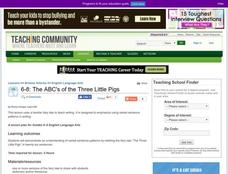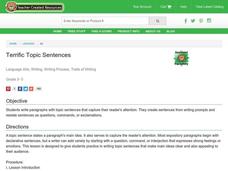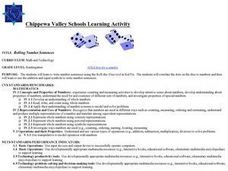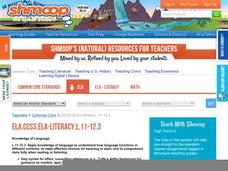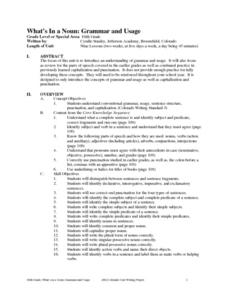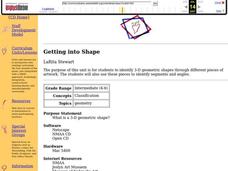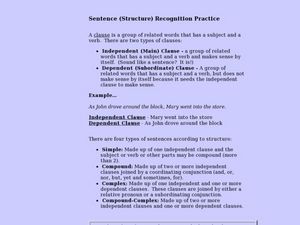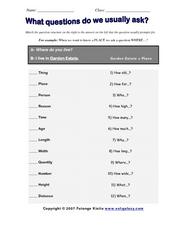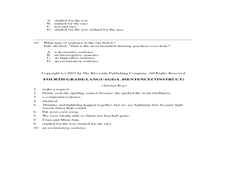Curated OER
A Simple Task Made Complex: Types of Sentences
Looking for a lesson about differing sentence types? Use this lesson on compound and complex sentences in your grammar unit. After composing simple, compound, complex and compound-complex sentences individually and as part of a group,...
Curated OER
Types of Sentences
In this language arts worksheet, students practice their skills in writing and placing punctuation marks for exclamatory, declarative, imperative, and interrogative sentences. Students complete 16 problems, and an answer key is provided....
Curated OER
Types of Sentences
Fourth graders identify and write different types of sentences. In this sentences lesson plan, 4th graders use pictures and animation to write declarative, interrogative, imperative, and exclamatory sentences.
Curated OER
Kinds of Sentences by Function Practice
In this kinds of sentences worksheet, students study examples of declarative, interrogative, imperative and exclamatory sentences. Students read ten sentences and tell what type they are and put in the ending punctuation.
Curated OER
The ABC's of the Three Little Pigs
Writers use varied sentence patterns. They listen to the story of Cinderella rewritten so that each sentence starts with the next letter of the alphabet. They create their own version of The Three Little Pigs using the same concept.
Curated OER
Terrific Topic Sentences
Capture the interest of your reader with terrific topic sentences. To practice hooking the reader, your class will be given writing prompts, and they must create topic sentences for each prompt provided. Encourage them to use different...
Curated OER
Rolling Number Sentences
Budding mathematicians investigate how to write number sentences using the Roll-the-Dice tool in "Kid Pix". They correlate the dots on the dice to numbers and then learn to use the addition and equal symbols to write number sentences....
Shmoop
ELA.CCSS.ELA-Literacy.L.11-12.3
Tired of simple sentences? Bored by brief sentences? Plagued by boring sentences? Enrich your life and the writing of your pupils by modeling how to combine sentences to create more varied syntax. Groups then find a number of ways to...
Curated OER
Renewable Energy Sentences
Students construct sentences using nouns and verbs from a "renewable energy" word bank. In this cross curriculum ecology and sentence structure grammar and mechanics lesson, students listen to the book Our Earth: Clean Energy by Peggy...
Curated OER
What's In a Noun: Grammar and Usage
Nine lessons in a grammar and usage unit provide endless opportunities for drill and practice. Topics include the four types of sentences, subject and predicates, nouns, verbs, adjectives, pronouns, adverbs and prepositions, conjunctions...
Curated OER
Getting into Shape
Young scholars identify 3-D geometric shapes through different pieces of artwork. They examine and identify segments and angles. Students act out shapes and create a piece of artwork. Additional cross curriculum activities are listed.
Curated OER
Sentence (Structure) Recognition Practice
In this sentence clauses worksheet, sixth and seventh graders read ten sentences and write down whether the sentence is: simple, compound, complex or compound-complex.
Curated OER
A Sentence for Life
What is a sentence? Second graders will explore the components of a sentence in the ten lessons of this unit. The subject, predicate, the process of proofreading, punctuation, and sentence sequence are analyzed in this unit. Handouts and...
EngageNY
True and False Number Sentences
True or false? Scholars determine the truth value of equations and inequalities through substitution. All values to use for substitution are given with each equation or inequality. This is the 24th lesson in a module of 36.
Curated OER
Of Mice and Men: Chapter 3 Reading and Study Guide
Boost comprehension with an excellent reading guide for chapter 3 Of Mice and Men. Learners define four vocabulary words, note one allusion, define five literary terms, and respond to 31 short answer questions regarding the...
Curated OER
Third Grade Language
In this language arts worksheet, 3rd graders answer multiple choice questions about types of sentences, subjects, compound words, predicates, and more. Students complete 25 questions.
Curated OER
Teaching Appositives
Explore appositives, phrases that immediately follow the noun they modify, using sentence strips, examples, and collaborative learning. The class works together to identify appositives and use commas to properly punctuate them. Partners...
Curated OER
Sample Sentences
For this sentence worksheet, students explore common conversational sentences as they match the question structure on the right to the answer on the left that the question usually prompts for.
Curated OER
Topic Sentences and Transitions
High school writers identify the purpose of both a topic sentence and a transitional statement. They write a topic sentence which denotes the paragraph topic and the author's stand on that topic. Then they write an effective transitional...
Nancy Fetzer's Literacy Connections
Expository Paragraph
Upper elementary and middle school writers learn how to craft an expository paragraph by following the six steps detailed in a 48-page instructional guide. Learners learn how to write six different types of informational paragraphs:...
EngageNY
True and False Equations
What does English have to do with math? Teach your class the "grammar" of a number sentence. Sentences with correct grammar can be false! Understanding of a number sentence leads to a comparison with equations.
Curated OER
Sentence Stucture
In this analyzing sentences worksheet, 4th graders identify purpose, combining, types, and grammar. Students answer 10 questions.
EngageNY
Grade 9 ELA Module 3, Unit 3, Lesson 7
As the unit on research writing draws to a close, class members continue to revise and edit their papers, this time focusing on grammar, spelling, and punctuation (colon and semicolon).
Curated OER
Language Arts: Sentence Variety and Fluency
Students are able to identify, create, and evaluate three kinds of sentences: simple, compound, and complex. They are able identify the purpose of various sentence types: declarative, interrogative, imperative, exclamatory, and...




